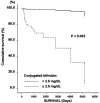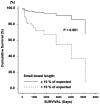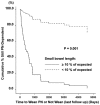Pediatric short bowel syndrome: redefining predictors of success
- PMID: 16135926
- PMCID: PMC1357748
- DOI: 10.1097/01.sla.0000179647.24046.03
Pediatric short bowel syndrome: redefining predictors of success
Abstract
Objective: To determine predictors of survival and of weaning off parenteral nutrition (PN) in pediatric short bowel syndrome (SBS) patients.
Summary background data: Pediatric SBS carries extensive morbidity and high mortality, but factors believed to predict survival or weaning from PN have been based on limited studies. This study reviews outcomes of a large number of SBS infants and identifies predictors of success.
Methods: Multivariate Cox proportional hazards analysis was conducted on 80 pediatric SBS patients. Primary outcome was survival; secondary outcome was ability to wean off PN. Nonsignificant covariates were eliminated. P < 0.05 was considered significant.
Results: Over a mean of 5.1 years of follow-up, survival was 58 of 80 (72.5%) and 51 weaned off PN (63.8%). Cholestasis (conjugated bilirubin > or =2.5 mg/dL) was the strongest predictor of mortality (relative risk [RR] 22.7, P = 0.005). Although absolute small bowel length was only slightly predictive, percentage of normal bowel length (for a given infant's gestational age) was strongly predictive of mortality (if <10% of normal length, RR of death was 5.7, P = 0.003) and of weaning PN (if > or =10% of normal, RR of weaning PN was 11.8, P = 0.001). Presence of the ileocecal valve (ICV) also strongly predicted weaning PN (RR 3.9, P < 0.0005); however, ICV was not predictive of survival.
Conclusions: Cholestasis and age-adjusted small bowel length are the major predictors of mortality in pediatric SBS. Age-adjusted small bowel length and ICV are the major predictors of weaning from PN. These data permit better prediction of outcomes of pediatric SBS, which may help to direct future management of these challenging patients.
Figures





References
-
- De Potter S, Goulet O, Lamor M, et al. 263 Patient-years of home parenteral nutrition in children. Transplant Proc. 1992;24:1056–1057. - PubMed
-
- Grosfeld JL, Rescorla FJ, West KW. Short bowel syndrome in infancy and childhood: analysis of survival in 60 patients. Am J Surg. 1986;151:41–46. - PubMed
-
- Messing B, Crenn P, Beau P, et al. Long-term survival and parenteral nutrition dependence in adult patients with the short bowel syndrome. Gastroenterology. 1999;117:1043–1050. - PubMed
-
- Moukarzel AA, Haddad I, Ament ME, et al. 230 Patient years of experience with home long-term parenteral nutrition in childhood: natural history and life of central venous catheters. J Pediatr Surg. 1994;29:1323–1327. - PubMed
-
- Vanderhoof JA, Matya SM. Enteral and parenteral nutrition in patients with short-bowel syndrome. Eur J Pediatr Surg. 1999;9:214–219. - PubMed
MeSH terms
LinkOut - more resources
Full Text Sources
Other Literature Sources
Medical

